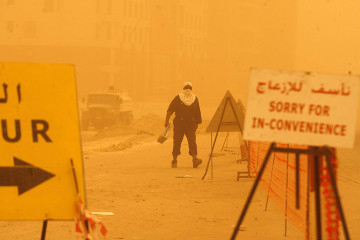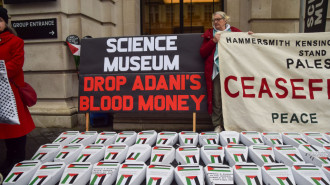
A transboundary threat: The prevalence of sandstorms in the GCC pose a severe climate risk

Climate change has led to more high-speed sandstorms in MENA, with the United Nations stating that the region is set to annually lose $13 billion due to environmental disruption.
The result of strong wind lifting bare, dry soil up into the atmosphere (known as "shamals"), SDSs – sand and dust storms – are the latest in a long line of climate challenges faced by the MENA region and other arid areas in Earth.
The threat posed by sand and dust storms is particularly acute in the Middle East as the region is heating up twice as fast as other areas at risk, with desertification only making matters worse.
"What is most interesting is that there are barely any environmental cooperation between [GCC] states when it comes to climate change. Dust and sandstorms are a perfect example of a transboundary climate threat that demands collective action"
Economically, sand and dust storms have affected the three strategic waterways in MENA, leading to the disruption of energy supply routes – evidenced by the blocking of the Suez Canal for six days, a canal which holds oil trade worth $60 billion as well as 12 percent of global trade.
Since April of this year, the Gulf Cooperation Council (GCC) has been affected several times. Flights have been grounded in Kuwait and Saudi Arabia, and schools, offices and factories have been forced to shut down.
The UAE continually sends out dust storm alerts when the density of storms is high, there have been occasions where the Burj Khalifa – the world's tallest building – has not been visible.
On one particular occasion, dust and sandstorms in the UAE have extended more than three miles into the sky before migrating to surrounding areas. It is therefore clear that these events have had a widespread impact.
Saudi Arabia appears to have experienced the worst impact. According to the Royal Commission for Riyadh City, the capital has experienced dust storms for at least 35 days of the calendar year. 1200 people have already been hospitalised with breathing difficulties.
In the past, sand and dust storms used to be considered “largely ungovernable” with few preventive measures taken.
Dr Tobias Zumbraegel, a postdoc researcher at the Center for Applied Research in Partnership with the Orient (CARPO) told The New Arab, “Dust and sandstorms have been a regularly occurring phenomenon in the region, climate change has only intensified this. Hence, it is very difficult (almost impossible at a large scale) to eliminate the sources of SDSs but you can mitigate the impact.”
So what can be done? First, planting trees and vegetation remains the best solution. A lack of greenery makes a lot of difference, with sparsely covered Kuwait often hit by storms three months a year. In Kuwait, dusty winds can reach 93-104 km per hour.
According to Benjamin Cook, an environmental scientist at Columbia University’s Climate School, wind, dust and dry conditions are the three factors that trigger a sandstorm.
Creating green belts reduces soil erosion and helps preserve moisture in the soil. As sandstorms impact almost all parts of Saudi Arabia, the country has planned to plant 10 billion trees to save the land from degradation, in doing so, decreasing its carbon footprint. However, decreasing precipitation levels and hotter temperatures remain a challenge for sustainable plantations.
Second, any lasting solution will have regional cooperation as the SDSs extend beyond borders. Dr Zumbraegel noted, “What is most interesting is that there are barely any environmental cooperation between [GCC] states when it comes to climate change. SDSs are a perfect example of a transboundary climate threat that demands collective action.”
He added, “Within the GCC, we have a climate committee where these topics need to be discussed (they certainly are) but this must also be followed by stronger cooperation between these states. However, it gets more problematic when we have storms that occur between countries that do not have the institutional regional framework to take action."
However, Riyadh has announced the Middle East Green Initiative to plant 40 billion more in the region, and this project was well-received by other GCC states like Qatar.
Outside the GCC, Iran has been working for three years to reduce sandstorm hot spots by planting trees, while Iraq has started planting, date, olive and eucalyptus trees.
|
Third, according to Dr Zumbraegel, “We need better data about when, where and to what extent these events occur so that we can encourage more monitoring, modelling and forecasting, along with the implementation of early warning systems.”
Some of the affected states have started installing early warning and monitoring systems to remain alert. The Masdar Institute in the UAE launched a high-tech dust forecasting system in 2016.
Finally, diverting water inland or growing vegetation or walls can help. Dust storms can cause agricultural damage and flooding with the sudden rises in river flows. Human-induced land degradation has multiplied the risk of sandstorms. The industrial construction of dams has also weakened water streams throughout the region.
Meanwhile, the duration of the storms is getting longer.
Explaining the slow progression of these phenomena, Diana Francis, head of the Environmental and Geophysical Sciences lab at Khalifa University in the UAE told CNN, “Melting ice in the Arctic is reducing the temperature between the polar region and mild latitudes and this makes the weather systems move slowly over our region. Convection [leading to storms] now can occur over several days whereas before, without climate change, it would have occurred over several hours and moved on.”
As climate change advances, such storms will continue to get more frequent.
Banafsheh Keynoush, a foreign affairs scholar and fellow at the International Institute for Iranian Studies has written that “Even renewable solar panels malfunction when covered by dust. Given these factors, it becomes evident that SDSs participate in a vicious cycle: Climate change causes storms, and the storms exacerbate the impacts of climate change. Socio-economic life revolves around weather patterns so livelihoods are severely threatened.”
Sabena Siddiqui is a foreign affairs journalist, lawyer, and geopolitical analyst specialising in modern China, the Belt and Road Initiative, the Middle East and South Asia.
Follow her on Twitter: @sabena_siddiqi
![A commuter waits to cross a street amid a heavy sandstorm in Kuwait City [Getty Images]](/sites/default/files/styles/medium_16_9/public/2022-07/GettyImages-1240707932.jpg?h=eec5a94e&itok=5KiGulqb)
![Foreigners wear medical masks as they walk in a street in Dubai amid a sandstorm [Getty Images]](/sites/default/files/styles/medium_16_9/public/2022-07/GettyImages-468340106.jpg?h=eec5a94e&itok=de1_FWIU)


